INSTITUT SUPERIEUR D'ANTHROPOLOGIE
INSTITUTE OF ANTHROPOLOGY
ONLINE COURSES / COURS A DISTANCE
FALL TERM : OCTOBER 2015
REGISTER NOW
INDE – 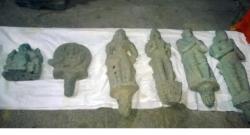 Thiruvalangadu - Six stone idols have been unearthed recently at the Vadaranyeswarar temple at Thiruvalangadu in Tiruvallur district. They were kept in the temple and the age of the idols was yet to be ascertained. Temple officials said the idols were found whey they dug the precincts to construct an annadhana mandapam. The idols of Vinayaga and Muruga are one-foot tall and the idols of Appar, Sundarar, and Sambandar are three feet in height. The sixth idol was not clearly identified. “The idols may belong to 14th or 15th century. But only an archaeological study will throw light on the period,” said noted archaeologist Mr. Nagaswamy, while stressing the need for intimating the Archaeology department immediately after an idol was spotted. He said even digging process should be done under the supervision of archaeologists as careless handling would not only damage the idols, but also would destroy the method of burial of idols. “When idols, whether bronze or stone, are buried during war or invasion, the pit would be filled with river sand to protect them from climatic changes. The idols would be buried upside down and covered with a flat stone. A small stone would be placed on the top of the pit to identify them. A bundle of tharpai grass would be used to perform poojas for the stone,” he said. The idols found in the temple, where Lord Siva performed the dance for Karaikal Ammaiyar, assume importance because it was here in 1904 a total of 32 copper plates issued by Rajendra Chola in 1018 AD were found. Along with the copper plates, a copper box containing various items for performing poojas and beautiful bronze Nataraja idol were also found.
Thiruvalangadu - Six stone idols have been unearthed recently at the Vadaranyeswarar temple at Thiruvalangadu in Tiruvallur district. They were kept in the temple and the age of the idols was yet to be ascertained. Temple officials said the idols were found whey they dug the precincts to construct an annadhana mandapam. The idols of Vinayaga and Muruga are one-foot tall and the idols of Appar, Sundarar, and Sambandar are three feet in height. The sixth idol was not clearly identified. “The idols may belong to 14th or 15th century. But only an archaeological study will throw light on the period,” said noted archaeologist Mr. Nagaswamy, while stressing the need for intimating the Archaeology department immediately after an idol was spotted. He said even digging process should be done under the supervision of archaeologists as careless handling would not only damage the idols, but also would destroy the method of burial of idols. “When idols, whether bronze or stone, are buried during war or invasion, the pit would be filled with river sand to protect them from climatic changes. The idols would be buried upside down and covered with a flat stone. A small stone would be placed on the top of the pit to identify them. A bundle of tharpai grass would be used to perform poojas for the stone,” he said. The idols found in the temple, where Lord Siva performed the dance for Karaikal Ammaiyar, assume importance because it was here in 1904 a total of 32 copper plates issued by Rajendra Chola in 1018 AD were found. Along with the copper plates, a copper box containing various items for performing poojas and beautiful bronze Nataraja idol were also found.
http://www.thehindu.com/news/cities/chennai/six-stone-idols-unearthed-at-thiruvalangadu/article7657153.ece
INDE – 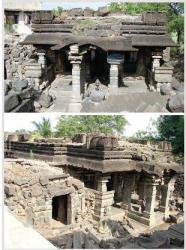 Hattar Sankudal - Two rather divergent sects of Hinduism — Vaishnavism and Shaivism — find a rare meeting point at the Harihareshwar temple, aptly situated at the confluence of the Bhima river and its tributary, Sina, in Solapur district's Hattar Sankudal village. A professor from the district had stumbled upon this little-known 11th and 12th century stone shrine around 17 years ago. Reduced to ruins by the vagaries of time, this Chalukyan era relic will now be restored by Maharashtra's archaeology department. "The Harihareshwar temple has two sanctums — one of Vishnu and the other of Shiva. It was discovered by professor Gajanan Bhide from Dayanand College, Solapur, after he carried out an excavation at the site along with his students," said Vilas Wahane, the state archaeology department's assistant director. Bhide had found some traces and when he cleared the mud, more of the temple emerged. Over a period of time, as the ground level had increased, it had got buried. The lower parts, which had been underground, are intact, but the upper parts are in a state of disrepair. Vandals have also scribbled on the walls. Considering that the ground level is now higher, water also accumulates within the temple premises. It has been declared a State Protected Monument by Maharashtra's archaeology department, which is now going to construct a compound wall around the temple to protect it. It has a Swarga Mandap (open mandap), which was rare in the old state temples during that time. The shrine also has beautiful carvings as the Chalukyans paid special attention to decoration. "The original temple did not have any binding material like mortar. It was secured with the use of iron claps. We plan to do the same. Only where absolutely needed are we going to use limestone," Wahane stressed, adding that the work is definitely going to be challenging. "The vandals have written names and spoilt the walls. We have to now clean it up with the use of chemicals. Moreover, we will be using the original stones as much as possible for the temple structure and the sculptures that have fallen down. Finding which stone is from where is also going to be a daunting task," the assistant director confided, saying the parts which are missing will be built anew.
Hattar Sankudal - Two rather divergent sects of Hinduism — Vaishnavism and Shaivism — find a rare meeting point at the Harihareshwar temple, aptly situated at the confluence of the Bhima river and its tributary, Sina, in Solapur district's Hattar Sankudal village. A professor from the district had stumbled upon this little-known 11th and 12th century stone shrine around 17 years ago. Reduced to ruins by the vagaries of time, this Chalukyan era relic will now be restored by Maharashtra's archaeology department. "The Harihareshwar temple has two sanctums — one of Vishnu and the other of Shiva. It was discovered by professor Gajanan Bhide from Dayanand College, Solapur, after he carried out an excavation at the site along with his students," said Vilas Wahane, the state archaeology department's assistant director. Bhide had found some traces and when he cleared the mud, more of the temple emerged. Over a period of time, as the ground level had increased, it had got buried. The lower parts, which had been underground, are intact, but the upper parts are in a state of disrepair. Vandals have also scribbled on the walls. Considering that the ground level is now higher, water also accumulates within the temple premises. It has been declared a State Protected Monument by Maharashtra's archaeology department, which is now going to construct a compound wall around the temple to protect it. It has a Swarga Mandap (open mandap), which was rare in the old state temples during that time. The shrine also has beautiful carvings as the Chalukyans paid special attention to decoration. "The original temple did not have any binding material like mortar. It was secured with the use of iron claps. We plan to do the same. Only where absolutely needed are we going to use limestone," Wahane stressed, adding that the work is definitely going to be challenging. "The vandals have written names and spoilt the walls. We have to now clean it up with the use of chemicals. Moreover, we will be using the original stones as much as possible for the temple structure and the sculptures that have fallen down. Finding which stone is from where is also going to be a daunting task," the assistant director confided, saying the parts which are missing will be built anew.
http://www.punemirror.in/pune/others/Solapurs-Chalukyan-era-shrine-to-get-back-its-lost-shine/articleshow/48975641.cms
FRANCE –  Alfortville - Dans le cadre d’un projet d’aménagement dans la commune d’Alfortville, au 7 rue de la Digue, un diagnostic archéologique va être réalisé par le service Archéologie du Conseil départemental du Val-de-Marne du 7 au 18 septembre. Deux archéologues interviendront sur une parcelle qui se situe dans une zone alluvionnaire au fort potentiel archéologique. Les travaux envisagés dans ce secteur sont susceptibles d’affecter des vestiges archéologiques allant du néolithique à la période moderne. Fin 2014, une opération archéologique avait déjà permis de mettre au jour une occupation humaine de la période protohistorique et une structure contemporaine.
Alfortville - Dans le cadre d’un projet d’aménagement dans la commune d’Alfortville, au 7 rue de la Digue, un diagnostic archéologique va être réalisé par le service Archéologie du Conseil départemental du Val-de-Marne du 7 au 18 septembre. Deux archéologues interviendront sur une parcelle qui se situe dans une zone alluvionnaire au fort potentiel archéologique. Les travaux envisagés dans ce secteur sont susceptibles d’affecter des vestiges archéologiques allant du néolithique à la période moderne. Fin 2014, une opération archéologique avait déjà permis de mettre au jour une occupation humaine de la période protohistorique et une structure contemporaine.
http://www.vmtv.fr/Diagnostic-archeologique-a-Alfortville_a650.html
ROYAUME UNI – 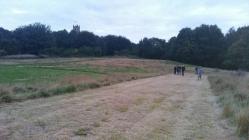 Lancaster - The city’s first major archaeological dig in 40 years kicks off tomorrow, Thursday, near Lancaster Castle. Lancaster District Heritage Group will be leading the dig at Quay Meadow, between the castle and St George’s Quay, and will be on site for six days. The group is hoping to uncover a Roman port on the site, after a geophysical survey carried out las year recorded a grid pattern under the ground.
Lancaster - The city’s first major archaeological dig in 40 years kicks off tomorrow, Thursday, near Lancaster Castle. Lancaster District Heritage Group will be leading the dig at Quay Meadow, between the castle and St George’s Quay, and will be on site for six days. The group is hoping to uncover a Roman port on the site, after a geophysical survey carried out las year recorded a grid pattern under the ground.
http://www.lancasterguardian.co.uk/news/local/big-roman-dig-starts-in-lancaster-1-7464840?
CHINE - Dahinggan Mountains - Archaeologists in China have discovered over 1,800 ancient cliff paintings dating back thousands of years and scattered across 31 sites in the country’s northeast Heilongjiang Province. Discovered first in 2012, the paintings which include images of humans and animals are spread out over 167,000 square kilometres. The paintings were painted by primitive hunters who inhabited Dahinggan Mountains at least thousands of years ago, Zhang Wei, director of the provincial institute of cultural relics and archaeology, was quoted as saying by the state-run Xinhua news agency on Wednesday. The humans shown on the work are both alone and in groups, with some wearing feather headdresses. The animals depicted include wolves, dogs, horses, boars, deer, tigers and birds, besides an s-shaped creature with four horns, which the researchers presumed may be a dragon. It is believed the hunters drew the patterns with their bare hands by using mixed pigments in the warm season. The findings will help in detailed study of the culture of early humans, researchers have said.
http://www.thehindu.com/news/international/1800-paintings-dating-back-thousands-of-years-found-in-china/article7659743.ece?
BULGARIE – 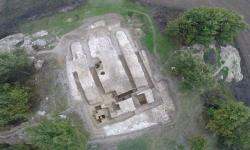 Shumen - Signs such as upsilons, swastikas, half-swastikas, and others have been found on bricks and tiles by the archaeologists excavating a 9th century AD Ancient Bulgar aul (a fortified settlement) near thenortheastern Bulgarian city of Shumen which was a residence of Bulgarian Khan (or Kanas) Omurtag (r. 814-831 AD), ruler of the First Bulgarian Empire (632/680-1018 AD), from its pagan period. The upsilons, swastikas, and half-swastikas found in the aul located near the town of Khan Krum (the modern-day town is named after Khan Omurtag’s father, Khan Krum (r. 803-814 AD)) are the same as the typical Ancient Bulgar signs discovered in the first capitals of the First Bulgarian Empire south of the Danube – Pliska (680-893 AD) and Veliki Preslav (Great Preslav) (893-970 AD), which are located in the same region in today’s Shumen District.
Shumen - Signs such as upsilons, swastikas, half-swastikas, and others have been found on bricks and tiles by the archaeologists excavating a 9th century AD Ancient Bulgar aul (a fortified settlement) near thenortheastern Bulgarian city of Shumen which was a residence of Bulgarian Khan (or Kanas) Omurtag (r. 814-831 AD), ruler of the First Bulgarian Empire (632/680-1018 AD), from its pagan period. The upsilons, swastikas, and half-swastikas found in the aul located near the town of Khan Krum (the modern-day town is named after Khan Omurtag’s father, Khan Krum (r. 803-814 AD)) are the same as the typical Ancient Bulgar signs discovered in the first capitals of the First Bulgarian Empire south of the Danube – Pliska (680-893 AD) and Veliki Preslav (Great Preslav) (893-970 AD), which are located in the same region in today’s Shumen District.
http://archaeologyinbulgaria.com/2015/09/14/archaeologists-find-upsilon-swastika-signs-in-ancient-bulgar-aul-in-northeast-bulgaria/
PEROU – 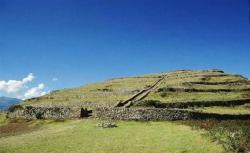
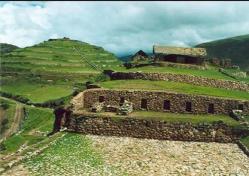 Sondor - Sondor archaeological complex was a place where religious activities occurred; hence the location and the shape of its central pyramid and its strategic vision to the Pacucha lagoon. One of the first discoveries was the sector of Muyu Muyu, Sondor’s sacred promontory, that has had its staircases and terraces restored. To climb the 500 steps to reach the grass at the top of the central pyramid gives you an interesting satisfaction. It’s a huaca where presumably human sacrifices were practiced. In the background of this scenario, you can enjoy a view of the lagoon and the Pacucha fields. In the ruins of Sondor the epic Chanka is represented, in which their leader was Anccohuayllo who, before the dangers of the Incas was represented, decided to march over Cusco and fought against his opponents.
Sondor - Sondor archaeological complex was a place where religious activities occurred; hence the location and the shape of its central pyramid and its strategic vision to the Pacucha lagoon. One of the first discoveries was the sector of Muyu Muyu, Sondor’s sacred promontory, that has had its staircases and terraces restored. To climb the 500 steps to reach the grass at the top of the central pyramid gives you an interesting satisfaction. It’s a huaca where presumably human sacrifices were practiced. In the background of this scenario, you can enjoy a view of the lagoon and the Pacucha fields. In the ruins of Sondor the epic Chanka is represented, in which their leader was Anccohuayllo who, before the dangers of the Incas was represented, decided to march over Cusco and fought against his opponents.
http://www.peruthisweek.com/travel-apurimac-sondor-complex-beautiful-green-pyramid-107007